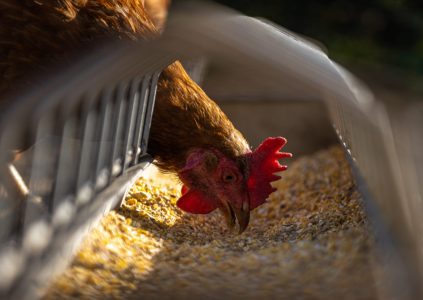Oils are commonly used as energy sources in laying hen diets, exerting multiple effects such as:
- Improving palatability
- Increasing feed consumption
- Strengthen immunity
- Reducing morbidity
When compared with broiler diets, the amount of oil that is added in laying hen diets is low. This is due to the fact that laying hens find themselves in a unique physiological state and are more likely to suffer from lipid metabolism disorders.
The lipids found in the egg yolk are mainly derived from dietary oils and therefore these play a crucial role in laying hens’ productive performance and egg quality.
The main types of oils used in laying hen diets are from plant and animal origin.
Vegetable oils commonly used in poultry feed are rich in unsaturated fatty acids (UFAs). These are important for the growth and development of laying hens. This is especially true for linolenic acid and linoleic acid, which are essential fatty acids (EFAs).
Linolenic acid deficiency hinders development and reduces production yield, while linoleic acid is deposited directly into the egg yolk and thus increases the weight of the egg through an increase in yolk weight(Kostik et al. , 2015). [register]
Some of the most common vegetable oils used in feed are: soybean, rapeseed, palm and flaxseed oil.
Animal oils (mainly triglycerides (TG)) are extracted from animal fat tissue.When included in diets, these fats increase the UFA content of eggs (O’Brien, 2008; Kralik et al. , 2021).
Animal oils which are commonly used in feed mainly include lard, poultry fat, tallow, and fish oil.
In general, these oils contain more saturated fatty acids (SFA) than vegetable oils (Wang et al., 2015).
The inclusion of oils to laying hen diets has become an effective method for:
- Promoting animal growth
- Increasing conversion rates
- Improving the health of birds
In addition, oils have adhesion properties that reduce dust in poultry feed production, promote better particle aggregation, reduce machinery wear and result in low waste and food savings.
The unique aroma of oils can improve feed palatability enhancing its flavor, and leading to higher intake levels.
The addition of oils also contributes to heat stress reductions, which improves feed utilization and reduces mortality(Palmquist, 2009).
The fatty acid composition and physicochemical properties of different types of oils as well as their physiological effects on laying hens vary substantially (Grobas et al. , 2001).
As a result of increased research on animal nutrition, higher animal welfare requirements, environmental protection and productivity, several properties of dietary oils have been discovered and tested.
Effect of oils on lipid metabolism in laying hens
During the egg-laying period, the amount of fat added to laying hen diets is usually less than 10%. The amount of lipids that laying hens get from feed is about 3 g a day, and between 5 and 6 g are needed for the formation of each individual egg.
- Therefore, some lipids are synthesized endogenously by hens.
Vegetable oils rich in polyunsaturated fatty acids (PUFAs) relieve fatty liver syndrome in laying hens, which favors lipid metabolism in laying hens. Meanwhile, excess consumption of animal oils or starch can aggravate fatty liver syndrome(Mateo and Savage, 2001; Schumann et al., 2003)).
Egg yolks are rich in PUFAs, which are divided into ω3 and ω6. Studies have shown that both ω3 and ω6 fatty acids exert anti-cancer effects. This is especially true for the latter.
Immunomodulatory effect of oils
Fatty acids found in oils play an important role in maintaining the health of birds. PUFAs are involved in the synthesis of biofilm structures and are precursors to a variety of physiologically active substances, such as eicosanoids and leukotrienes (Certík et al. , 2013).
Several PUFAs, such as linolenic acid and arachidonic acid, are components of the cell membrane and are essential in maintaining the integrity of the cell membrane’s structure and function.
In modern egg production, laying hens are usually subjected to high-intensity production pressure. Heat stress and oxidative stress (OS) are common factors that affect the productive performance of laying hens (Getabalew and Negash, 2021).
- The digestion and absorption efficiency for oil is very efficient, and its heat increase is significantly lower than that of carbohydrates and proteins.
This property can substantially reduce the heat dissipation load on the animal’s body during the summer. This is particularly significant in the production of high-density laying hens. Contributing to reduce heat stress and improve feed conversion rates.
[/register]
Source: Zhouyang Gao y col., 2021
